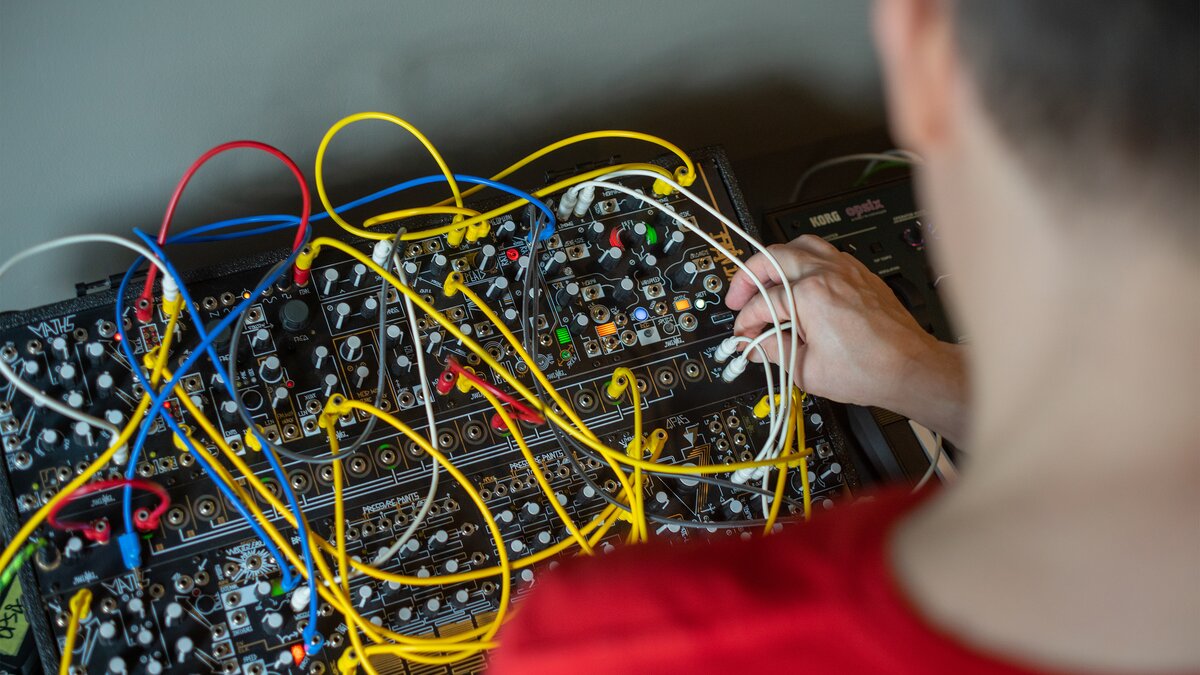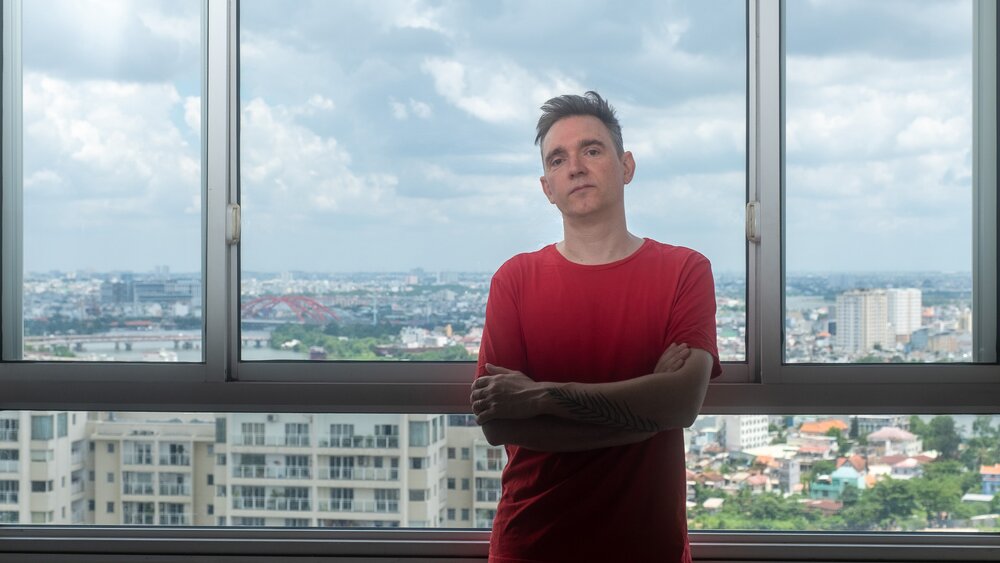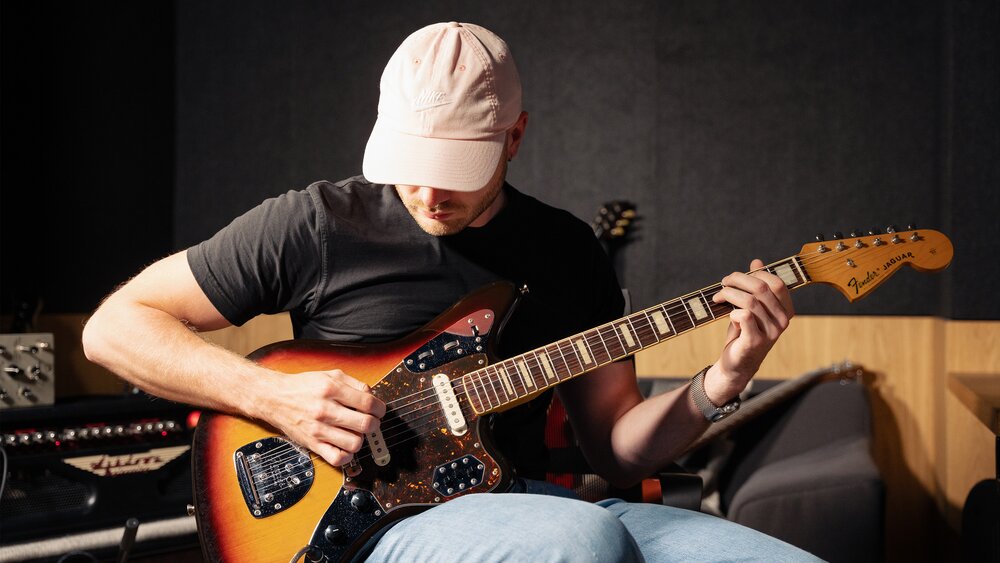From blank canvas to sonic inventions

Peter Van Hoesen's musical brain adds another layer of meaning to the name of Orchestral Tools' new sample library, Konduit. Not only is his brain the conduit through which ideas flow, it provides a glimpse into the improvisatory and live side of sound design in all its open-ended possibilities. There's an intense method that allows the neurons to connect quickly as he builds new patches from scratch.
Van Hoesen has turned entirely to live performance in his techno shows, bringing the same expansive sound worlds from his productions into the live context, both as a solo artist and when working with AtomTM or as half of Sendai. Here, he focuses on synths and sound processing, while Orchestral Tools’ Cornelius Duerst adds guitar and bass layers produced with various techniques—a kind of sound design counterpart to Peter’s other duos. Many of those layers are so heavily processed you may not recognize the guitar source, like an additional dimension of sound synthesis.
We were curious what supports this generative creative process, and how these sounds evolve from patches and gear to processing and the final signal chain. Peter’s keeping up a prolific tour schedule with those all-live shows, so he spoke to us between dates from his home base in Vietnam.
Peter, your productions and live sets always have these rich worlds and attention to sound design and timbral imagination. Would you say that’s related to your work here? How would you relate the domain of techno to these elements of sound in the experimental or even ambient sense?
Peter Van Hoesen: For me, producing electronic music—specifically techno—has a big explorative component. For me, it needs to have an element of research, of finding new sounds and methods. This is part of the attraction of electronic music for me, the fact that we have been given all these fantastic tools to go and explore. So there’s definitely a link between my solo work and the way I approached the sound design of Konduit.
How is improvisation with machines a part of your work? And is there a way that you set up machines to give yourself the capacity to be spontaneous with them - what kind of advance preparation do you do (in patching or practicing or what have you)?
With Konduit, we had talked extensively about what kind of sound design we were going to pursue -- what Konduit would stand for. Those reflections then nudge the entire compositional process in a specific direction. So I would say it was more focused and goal-oriented than how I usually work. Also, Konduit is a unique library as it combines a synthesized layer with a processed guitar-based layer. It was clear from the start that this would be the core concept of the library. This helped me to find a clear direction and aesthetic.
As for the practical side of things, I always start with a completely unpatched system, except for the final outputs going into the audio interface; those are usually fixed. The rest is a blank canvas, that's how I prefer to approach things. This way my decisions are less defined by past movements and will have more variation over a series of recording sessions.

You’ve worked as Sendai with Yves De Mey, and I know you’re working with Uwe Schmidt (Atom™), too. In those collaborations, how do you play together? How do you stay in sync (artistically and technically)?
It's rather simple. We're not very synced in the sense that we do not record together or rehearse. I live in Asia, Uwe lives in Chile, Yves De Mey lives in Belgium. The only exchange is done online when we send over audio files. But to be honest, this does not happen that often. When performing onstage with Uwe as SYNC, it's 100% a game of improvisation. We listen to each other and set up a musical conversation. No rehearsals, just one long jam.
With Sendai, our shows were more structured but even then there was a lot of room for improvisation. It's important when you play live to allow yourself the possibility to take different directions with each performance. That keeps it fresh. As for the practical aspects of keeping things synced, good old MIDI and Ableton Link always do the trick.
Cornelius, can you tell us a little bit about Konduit - what was the concept? What sort of stuff should we expect to hear?
Cornelius Duerst: At least for me, this library aims to sonify electricity using only electronic sound sources and it picks up on the thought of music being made from electricity. Modular synthesizers are a very good example of that as we use voltage to control different parameters of the sound.
A big part of Konduit was playing with layering instruments – I was inspired by a piece I made about a decade ago, adding distorted electric guitar sounds to a synth. Layering sounds like this just takes synthesizer sounds to another level for me, having a component that’s imperfect. You add this element of mechanical noise and additional expression.
When I first played the final patches in Konduit I was really happy with how organic and yet “unreal” they sounded and felt. The three categories of Konduit’s library cover different sound aesthetics but are still connected by their style. Under “Surge” you’ll find very intense and heavily distorted patches. The sounds in “Charge” are a bit reduced in terms of intensity. They are rather atmospheric and glitchy. The patches in “Spark” are more harmonic and less eerie than “Charge.”
And you worked with some DIY pedals, too, right?
Yes, I also used two different guitar pedals I built. One is a tube preamp. The other is a tricked-out Tonebender MkIII Fuzz - it has different ways to “throttle” the sound by choosing different resistor and capacitor values. Higher values make the signal break up. It also has a built-in feedback switch that makes the circuit self-oscillate when turned on.
Part of designing a great sample library is both capturing that sense of your performance and allowing the user to perform and work with those sounds in different ways. Peter, how did you organize that process, and how did you fit these elements together?
Peter Van Hoesen: From the beginning, we checked carefully to see if my sound design matched up with the processed guitar sounds. It was a continuous process of going back and forth, communicating extensively with Cornelius to make sure everything fitted together perfectly. We were constantly thinking about how the different sounds would interact in specific situations. Personally, I would constantly reflect on how a certain sound could be used, if it would make creative sense to use over different octaves, or if it was only really relevant in the lower frequencies, etc. These considerations, when applied consistently, improve the user experience to a great extent. It is that combination of being experimental while being focused at the same time which results in something unique.
And Cornelius, part of the concept here is morphing between layers - and you added these guitar and bass parts by recording and processing various bows and articulations. Can you tell us what those materials were like? How did you play and record them?
Cornelius Duerst: For the guitar layer, I used a selection of different guitars and also a bass guitar. The main guitar is a Fender Jaguar Big Block 66' Reissue. It uses single coils but is very versatile in use. I also used a Les Paul Studio with Humbucker pickups and an automatic tuning system that I took advantage of for experimenting with open tunings. You’ll also hear a five-string Warwick bass and a PRS Baritone guitar.
The bass was recorded exclusively through a DI box, but all the guitars were all played through a 90’s Ashdown all-tube amp and a Framus 2x12 cabinet with Celestion Vintage 30 speakers. I recorded two different mics, a Royer R-121 ribbon mic and a Neumann TLM103 – sometimes replacing the Neumann with a Shure SM57, depending on the sound I wanted to get. We also recorded a DI signal for the guitars. After cleaning/denoising the recordings, I processed them through modular effects. That system consisted mainly of different filter and distortion units, but also frequency shifters, delays and modulation sources (LFOs, envelope followers, etc.). It’s a stereo system, so most of the modules are doubled or have two channels, which is very nice when adding modulation as you can alter the left and right channel independently. On some patches, I also used a 19" tube processor by SPL. Some of the sounds were also pre-processed using digital plugins and then further processed through the modular system. I recorded a variety of different irregular articulations using different “exciters” such as guitar pics, mallets, (felted/wood tip), brushes, or just my fingers. For sustained sounds, I used an e-bow but also a cello bow. As mentioned earlier, I also used open tunings and tunings as low as C on the Jaguar. But the sounds were sometimes further lowered within Pro Tools.
All the articulations were recorded chromatically in their patterns so the behavior is different for every key, which in my opinion adds a new dimension of realism and feeling to it.

Of course, the recording chain matters. Back to Peter - have you got a particular signal chain that establishes a sound for this? Or did you create a few different chains for particular tasks? What are you using?
Peter Van Hoesen: So I thought up a specific chain for Konduit. I knew that I would use hardware for the synthesis aspect, combined with elements of my outboard effects chain, to give the library a specific and unique character. The Cranborne Audio Camden 500 preamps are a big part of the sound as well as the Tubetech SMC 2B multiband compressor. They were there on every recording session, so each sound passed through these two machines. Additionally, for certain sounds, I applied extra EQ with the IGS Rubber Bands and extra compressions with the Elysia Xpressor and my pair of Distressors. These last ones are also responsible for adding a touch of harmonic saturation.
For each sound, there was a lot of going back and forth between these elements until it sounded exactly as I wanted it. I added a healthy dose of digital processing afterward, which took things up another notch. The entire recording and processing chain is definitely a big part of the sound of Konduit.
How do you go about recording? Do you sort of leave things rolling and go back and cut later, or is it more a lot of tweaking, than capturing moments? Especially with a sound library in mind...
I usually spend some time designing and refining a patch before recording. When I am 80 percent there I check to see if the sound works well over a range of several octaves. I found that with the modular system and the complex modulation possibilities a sound could sometimes change its character over different pitch ranges. When making techno I usually don’t care that much about this issue, but for Konduit I had to make sure everything remained consistent. Checking these aspects of the process is vital if you don’t want to be surprised later on. The last step is to go back to the patch, refine it until I am happy with it, and then record it.
Let’s chat modules. Do you have some favorite, go-to stuff for particular tasks? Make Noise seems to figure in there - and the SOMA Cosmos must get interesting.
The first part of the recording sessions was mostly oriented towards using FM processes applied to Eurorack modules such as Make Noise DPO, the Xaoc Devices Odessa, and the Quad Operator by Humble Audio. At the moment I find FM synthesis the most interesting form of sound design, so I tried to apply that interest in working with these two modules. As for modulation, a lot was done using CV signals sent from the DAW into the modular system, as this allowed me very precise control over curves and oscillations. And yes, anything going through the Cosmos gets interesting. I do not see it as an effects unit; for me, it’s an instrument. Once you know how to nudge it in the right direction, it becomes a very addictive piece of gear.
At the later stages of the process, I also involved the Korg Opsix, often combining it with modular sound and sending the summed signal through the recording chain. That yielded some really interesting results.
The Soma Cosmos is probably my favorite at the moment. It does amazing things with guitar but is equally fantastic with a modular system or a synthesizer.
In addition to checking out this sound library, I know we’re excited to catch your next live show. What informed that decision to be a live-only artist?
Mostly I needed a new challenge for myself, musically and in a performative sense. DJ sets were no longer satisfying me completely. Performing a 2-hour live set is a different thing altogether, which is exactly what I needed. On top of that, I feel as if there are fewer techno live performances these days, and fewer artists who are willing to go out there and play live. The practice of performing techno in a live context should not be forgotten about; it is a vital part of our music. I felt it was time for me to go and express that clearly.
I guess first and foremost I am a musician, it is as simple as that.